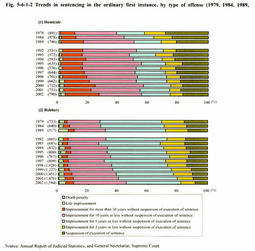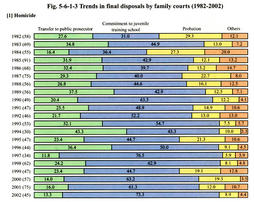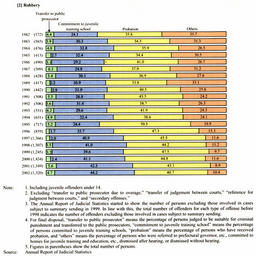| Previous Next Index Image Index Year Selection | |
|
|
2 Sentencing in trial and protective measures, etc. (1) Sentencing Fig. 5-6-1-2 shows the trends in sentencing in the first instance for homicide/robbery by percent distribution. As for homicide, statutory penalties are wide-ranging from imprisonment with labor for a limited term of 3 years or more to life imprisonment and the death penalty. Comparing the percent distribution of sentences in 1993 with that in 2002, the percentage of suspension of execution of sentence decreased by 6.5 points from 23.6% to 17.1%, and that of imprisonment for 10 years or less without suspension of execution of sentence decreased by 4.9 points, from 60.8% to 55.9%. In contrast, the total percentage of the death penalty, imprisonment with labor for life, and imprisonment with labor for a limited term of more than 10 years increased by 11.4 points, from 15.6% to 27.0%, showing the progress toward harsher sentences.
For robbery (including homicide on the occasion of robbery, robbery resulting in death or bodily injury, and rape on the occasion of robbery), statutory penalties include imprisonment with labor for a limited term of 5 years or more, life imprisonment, and the death penalty. Comparing the percent distribution of sentences in 1993 with that in 2002, the percentage of suspension of execution of sentence decreased by 7.0 points, from 15.4% to 8.4%, and that of imprisonment for 3 years or less without suspension of execution of sentence decreased by 6.7 points, from 16.3% to 9.6%. Contrary to that, imprisonment for more than 3 years but 10 years or less increased by 9.8 points, from 62.0% to 71.8%, and the percentage of the death penalty, imprisonment with labor for life, and imprisonment with labor for a limited time of 10 years or more increased by 4.0 points, from 6.2% to 10.2%. As with homicide, the tendency toward harsher sentence has been progressing. The facts that, as malicious cases increased among heinous offenses prosecuted, public prosecutors offices came to demand harsh sentences and courts also came to take a harsher stance against such offenses are considered to be behind this tendency. The harshest sentences for heinous offenses are the death penalty and imprisonment with labor for life. Those sentences has accounted for very small shares in the last 10 years (0.9-4.3% for homicide and 2.5-5.0% for robbery), showing that the harshest sentences are applied with utmost care. Fig. 5-6-1-2 Trends in sentencing in the ordinary first instance, by type of offense (1979, 1984, 1989,1992-2002) (2) Protective measures for juveniles Fig. 5-6-1-3 shows the trends in final disposals, such as protective measures, by family courts on juveniles who committed homicide/robbery (excluding transfer to public prosecutor due to overage). For homicide, juveniles committed to a juvenile training school have accounted for highest proportion, and not a few juveniles have been transferred to the public prosecutor. The percentages largely fluctuate depending on the year, since the number of juveniles disposed is small. Therefore, no clear trends due to the passing of years are seen, but the percentage of commitment to a juvenile training school has been on an upward trend. As for robbery, the percentage of commitment to a juvenile training school has been increasing. Comparing between 1993 and 2002, the percentage increased by 14.7 points, from 29.6% to 44.2%. The percentage of commitment to a juvenile training school and transfer to the public prosecutor reached about 50% in total, indicating a tendency toward harsher protective measures. This is probably because referred juvenile cases included increasingly more cases, that are considered to have been committed by juveniles who have stronger needs for protective measures.
Fig. 5-6-1-3 Trends in final disposals by family courts (1982-2002) |


